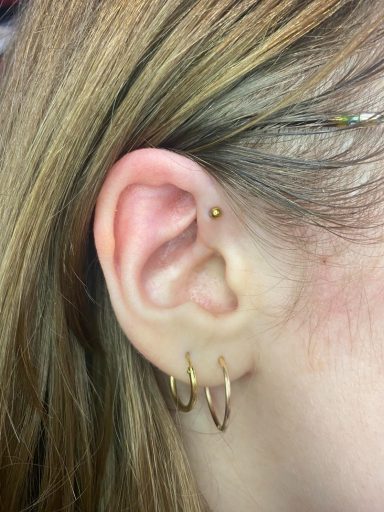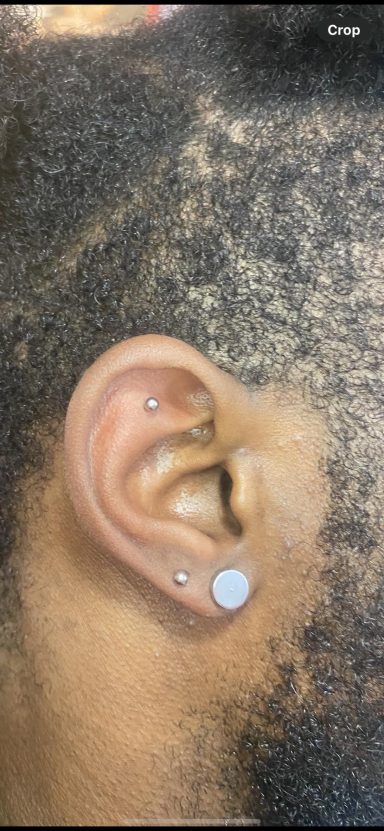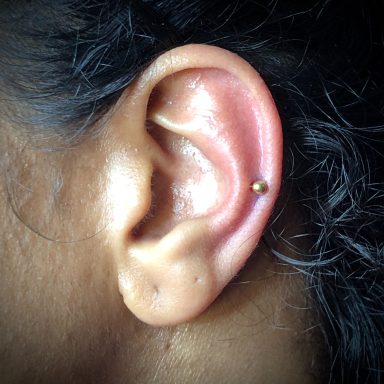Ear Piercing
The Piercing Experience
Safety is our top priority at Tiger & Rose. All of our equipment is single- use. We only pierce with titanium jewellery which is hypoallergenic. This means there is less of a risk of any allergic reaction to the metal.
You can book a consultation before-hand or just book an appointment. At your appointment, we will work with you to determine which piercing will suit your anatomy. The jewellery options will be explained to you and although basic jewellery is included in the price, you can upgrade it to something more sparkly if you'd like. Our piercer will mark a precise location as to where it should go and will get you to approve the spot.
The piercing itself is quick and you may be surprised that it's already over. We are confident that you're going to love your new look!

Ear Lobe Piercing
Pain Rating: 1-2 out of 10
Ear lobes are the most common piercing. These are located in the lower section of the ear and can done in the lowest part or upper part of the fleshy part of the ear. They’re usually the first piercing someone will get done as they are straight forward and are one of the least painless places to get pierced. It also has the quickest healing time.
Earlobes are pierced using a flat back bar. Once healed, you can change the jewellery.
Healing Time: 6- 8 weeks

Helix Piercing
Pain Rating: 4 out of 10
A helix piercing is one of the classic staples and is almost as common as lobe piercings. They are located in the mid to upper cartilage ridge of the ear. They can also be referred to as a cartilage piercing.
Helix piercings take a bit longer to heal than lobes and are pierced with studs. The jewellery is often downsized and can be changed to rings after 2-3 months.
Healing Time: 3- 9 months

Flat Helix Piercing
Pain Rating: 5 out of 10
A flat helix piercing is a great addition to the top of the ear; they can fill the space nicely and allow for a lot of interesting jewellery options. The flat helix is in the cartilage area of the ear, but on the flat area (rather than the ridged part).
It is vital that you downsize this piercing after around 1-2 months of healing time as it can be prone to migration.
Healing Time: 3-9 months

Conch Piercing
Pain Rating: 5 out of 10
A conch piercing is the perfect addition to any ear, it can be minimal or extravagant - it’s a little hidden within the ear but it creates a great focus point and helps bring your ear curation together!
A conch can be placed in a few different positions within the ear such as higher up or lower down, even the depth can change depending on the final look you want to achieve. When pierced closer to the outside of the ear, when healed a ring can be fitted which is called an Orbital. If you have this in mind let your piercer know so the placement will be just right to accommodate it.
Healing Time: 3-9 months

Tragus Piercing
Pain Rating: 4 out of 10
The tragus is the small piece of cartilage flap that partially covers the ear canal. These piercings are highly popular because they can be the focal point for the ear. It will be pierced with a bar, but when healed, it can be changed to a small dainty ring!
Healing Time: 3-9 months

Daith Piercing
Pain Rating: 7 out of 10
The daith is the inner most fold of cartilage of the ear- the crus of the helix. Daith piercings are a bit more uncommon (in comparison to other ear piercings) but the choices of jewellery are endless! It’s a great spot to help you create a stand out look effortlessly.
When pierced, we will use a horseshoe ring - the style of jewellery can sometimes depend on the space and your anatomy of your ear!
The daith piercing can also benefit those who suffer from migraines!
Healing Time: 3-9 months

Rook Piercing
Pain Rating: 3 out of 10
A rook piercing is placed on the upper most ridge of cartilage of the inner ear. They are a slightly more hidden but you can create a much fuller look to the ear with certain types of jewellery. They are also great if wanting to add a subtle sparkle.
We will fit a curved barbell with the rook piercing. It is recommended to downside after healing and you have the choice to also fit a ring if you’d like to do so.
It is crucial to clean this piercing thoroughly as it’s situated in a higher space in the ear. This spot can harbour more bacteria if not cleaned properly - a cause of this can be from hair washing and build up of hair products in and around the ear.
Healing Time: 3-9 months

Forward Helix Piercing
Pain Rating: 5 out of 10
A forward helix piercing is a great alternative to the classic helix piercing. You can have a single dainty earring in or you can have multiple piercings in this area for a more dramatic look.
The area is quite snug so it is advised to wait in-between piercings if you wanted more than one, as sometimes the area can swell. It can also be considered a more difficult one to clean thoroughly.
A forward helix will be pierced with barbell. Downsizing is recommended for this piercing
Healing Time: 3- 9 months

Anti Tragus Piercing
Pain Rating: 6 out of 10
If you’re looking for a more unique ear piercing, the Anti Tragus is a great option. It sits nicely just across from the tragus and can be worn with rings or bars!
To begin you will pierced with a curved barbell and you will need to wait around 3- 4 months before any jewellery changes as it is quite a deep piercing. Downsizing is recommended once healed.
Healing Time: 3- 9 months
Check out Some of our Work
Ear Piercing FAQs
Should I twist my ear piercing jewellery while cleaning it?
No. You are going to want to avoid touching the jewellery at all with your hands. Just cleanse with saline solution and cotton buds.
How long do I have to wait to change my earring?
We will let you know how long it will take to heal and when you can change your jewellery. We know that you may want to change it before this time, but if you do, you risk infection and also risk not being able to get the earring back in. Patience is best.
How do I know if my ear piercing is healed?
Piercings in general will be a bit swollen and sore for the fist few days. You may notice some fluid/ crust around the piercing too. When your eat piercing is healed, there will be no tenderness. There will be no discharge or redness. The jewellery will be loose and will move somewhat freely and without pain.
How can I tell if my ear piercing is infected?
If your ear piercing is red (or dark depending on your skin colour), painful, swollen and hot to the touch, it may be infected. If there is an infection, there may be white, green or yellow pus coming from the piercing.
What should I do if my ear piercing is infected?
If you find that your new piercing has become infected, call us at 07932783225. We can give you guidance or we may ask you to come in. Very often if you've been pierced by an inexperienced piercer, they may not have fit the best jewellery and the pain you experience may due to this.
Can I pierce my helix with a ring?
It's best to pierce your cartilage with a stud. It means that there will be less irritation and faster healing time. You can change this to a ring about 2-3 months after getting the piercing.
What is piercing migration?
Migration is when a piercing can begin to heal at an incorrect angle; this is most commonly caused by sleeping on the piercing ow wearing jewellery that is too big (or heavy). As a result of this, downsizing the piercing when it is healed will reduce the chance of it migrating.
For example, a longer bar can end up causing a big angle change if not downsized in the appropriate time frame given by your piercer.
We need your consent to load the translations
We use a third-party service to translate the website content that may collect data about your activity. Please review the details in the privacy policy and accept the service to view the translations.








